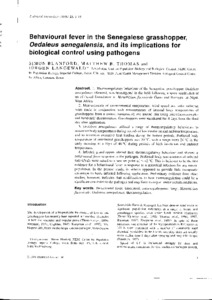| dc.contributor.author | Blanford, S. |
| dc.contributor.author | Thomas, M.B. |
| dc.contributor.author | Langewald, J. |
| dc.date.accessioned | 2019-12-04T11:22:27Z |
| dc.date.available | 2019-12-04T11:22:27Z |
| dc.date.issued | 1998 |
| dc.identifier.citation | Blanford, S., Thomas, M.B. & Langewald, J. (1998). Behavioural fever in the Senegalese grasshopper, Oedaleus senegalensis, and its implications for biological control using pathogens. Ecological Entomology, 23(1), 9-14. |
| dc.identifier.issn | 0307-6946 |
| dc.identifier.uri | https://hdl.handle.net/20.500.12478/4009 |
| dc.description.abstract | 1. Thermoregulatory behaviour of the Senegalese grasshopper, Oedaleus senegalensis (Krauss), was investigated in the field following a spray application of an oil-based formulation of Metarhizium flavoviride Gams and Rozsypal in Niger, West Africa. 2. Measurements of environmental temperature, wind speed and solar radiation were made in conjunction with measurements of internal body temperatures of grasshoppers from a control (unsprayed) and treated plot using microthermocouples and hand-held thermometers. Grasshoppers were monitored for 4 days from the third day after application. 3. Oedaleus senegalensis utilized a range of thermoregulatory behaviours to maximize body temperatures during periods of low insolation and ambient temperature, and to minimize excessive heat loading during the hottest periods. Preferred body temperature of uninfected grasshoppers was 39 °C, with a range from 24 °C in the early morning to a high of 46 °C during periods of high insolation and ambient temperature. 4. Infected grasshoppers altered their thermoregulatory behaviour and showed a behavioural fever response to the pathogen. Preferred body temperatures of infected individuals were raised to a new set point of ≈ 42 °C. This is believed to be the first evidence for a behavioural fever in response to a microbial infection for any natural population. In the present study, its effects appeared to provide little therapeutic advantage to hosts infected following application. Preliminary evidence from other studies, however, indicates that modifications to host thermoregulation could be a significant constraint to the pathogen and may limit its impact under certain conditions. |
| dc.description.sponsorship | Canadian International Development Agency |
| dc.description.sponsorship | Directorate-General for International Cooperation, the Netherlands |
| dc.description.sponsorship | Swiss Agency for Development and Cooperation |
| dc.description.sponsorship | Overseas Development Administration, United Kingdom |
| dc.language.iso | en |
| dc.subject | Behavioural Fever |
| dc.subject | Biocontrol |
| dc.subject | Entomopathogenic Fungi |
| dc.subject | Metarhizium |
| dc.subject | Flavoviride |
| dc.subject | Oedaleus Senegalensis |
| dc.subject | Thermoregulation |
| dc.title | Behavioural fever in the Senegalese grasshopper, Oedaleus senegalensis, and its implications for biological control using pathogens |
| dc.type | Journal Article |
| dc.description.version | Peer Review |
| cg.contributor.affiliation | Natural Environment Research Council, United Kingdom |
| cg.contributor.affiliation | International Institute of Tropical Agriculture |
| cg.coverage.region | Africa |
| cg.coverage.region | West Africa |
| cg.coverage.country | Niger |
| cg.isijournal | ISI Journal |
| cg.authorship.types | CGIAR and advanced research institute |
| cg.iitasubject | Plant Diseases |
| cg.iitasubject | Pests Of Plants |
| cg.iitasubject | Disease Control |
| cg.iitasubject | Climate Change |
| cg.accessibilitystatus | Limited Access |
| local.dspaceid | 99295 |
| cg.identifier.doi | https://doi.org/10.1046/j.1365-2311.1998.00104.x |

